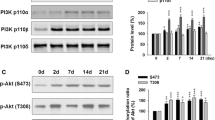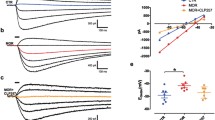Abstract
Rationale
We previously demonstrated that the morphine-induced rewarding effect was attenuated under a neuropathic pain-like state following partial sciatic nerve ligation in rodents. Furthermore, the up-regulation of protein kinase C (PKC) activity in the spinal cord is considered to be the key factor for induction of hyperalgesia following sciatic nerve ligation. However, little direct evidence is available for the involvement of activated PKC in the spinal cord in reduction of rewarding effects induced by morphine under chronic pain-like state.
Objective
The present study was to investigate whether direct activation of spinal PKC by intrathecal (IT) administration of a specific PKC activator, phorbol 12,13-dibutyrate (PDBu) could produce hyperalgesia and suppress the place preference induced by morphine in mice.
Method
The morphine-induced rewarding effect was investigated using the conditioned place preference method. Conditioning sessions (three for morphine, three for saline) were started 24 h after IT injection of PDBu or saline and conducted once daily for 6 days. On the day after the final conditioning session, a post-conditioning test was performed.
Results
IT-administered PDBu produced a long-lasting thermal hyperalgesia. Under these conditions, the place preference induced by morphine was abolished by a single IT pretreatment with PDBu. The effect was reversed by concomitant IT treatment with the specific PKC inhibitor Ro-32-0432. In contrast, IT-administered PDBu failed to affect the hyperlocomotion and supraspinal antinociception induced by morphine.
Conclusion
The present findings suggest that activated PKC in the spinal cord with chronic pain-like hyperalgesia may play a substantial role in the suppression of the morphine-induced rewarding effect in mice with chronic pain-like hyperalgesia.





Similar content being viewed by others
References
Altier N, Stewart J (1999) The role of dopamine in the nucleus accumbens in analgesia. Life Sci 65:2269–2287
Craig AD, Bushnell MC, Zhang ET, Blomqvist A (1994) A thalamic nucleus specific for pain and temperature sensation. Nature 372:770–773
Eddy NB, Leimbach D (1953) Synthetic analgesics. II. Dithienylbutenyl- and dithienylbutylamines. J Pharmacol Exp Ther 107:385–393
Enrico P, Mura MA, Esposito G, Serra P, Migheli R, De Natale G, Desole MS, Miele M, Miele E (1998) Effect of naloxone on morphine-induced changes in striatal dopamine metabolism and glutamate, ascorbic acid and uric acid release in freely moving rats. Brain Res 797:94–102
Flanklin KB (1998) Analgesia and abuse potential: an accidental association or a common substrate? Pharmacol Biochem Behav 59:993–1002
Funada M, Suzuki T, Narita M, Misawa M, Nagase H (1993) Blockade of morphine reward through the activation of κ-opioid receptors in mice. Neuropharmacology 32:1315–1323
Han ZS, Zhang ET, Craig AD (1998) Nociceptive and thermoreceptive lamina I neurons are anatomically distinct. Nat Neurosci 1:218–225
Hylden JL, Wilcox GL (1980) Intrathecal morphine in mice: a new technique. Eur J Pharmacol 67:313–316
Kim SH, Chung JM (1992) An experimental model for peripheral neuropathy produced by segmental spinal nerve ligation in the rat. Pain 50:355–363
Malmberg AB, Chen C, Tonegawa S, Basbaum AI (1997) Preserved acute pain and reduced neuropathic pain in mice lacking PKCγ. Science 278:279–283
Mao J, Price DD, Mayer DJ, Hayes RL (1992) Pain-related increases in spinal cord membrane-bound protein kinase C following peripheral nerve injury. Brain Res 588:144–149
Mao J, Price DD, Phillips LL, Lu J, Mayer DJ (1995) Increases in protein kinase C gamma immunoreactivity in the spinal cord dorsal horn of rats with painful mononeuropathy. Neurosci Lett 198:75–78
Narita M, Takahashi Y, Takamori K, Funada M, Suzuki T, Misawa M, Nagase H (1993) Effects of kappa-agonist on the antinociception and locomotor enhancing action induced by morphine in mice. Jpn J Pharmacol 62:15–24
Narita M, Yajima Y, Aoki T, Ozaki S, Mizoguchi H, Tseng LF, Suzuki T (2000) Up-regulation of the TrkB receptor in mice injured by the partial ligation of the sciatic nerve. Eur J Pharmacol 401:187–190
Narita M, Funada M, Suzuki T (2001) Regulations of opioid dependence by opioid receptor types. Pharmacol Ther 89:1–15
Ohsawa M, Narita M, Mizoguchi H, Suzuki T, Tseng LF (2000) Involvement of spinal protein kinase C in thermal hyperalgesia evoked by partial sciatic nerve ligation, but not by inflammation in the mouse. Eur J Pharmacol 403:81–85
Ostrowski NL, Caggiula AR (1991) Correlation between locomotor stimulation and the electrophysiological effects of low doses of morphine on substantial nigra dopamine neurons. I. Acute drug administration. J Pharmacol Exp Ther 251:72–81
Ozaki S, Narita M, Narita M, Iino M, Sugita J, Matsumura Y, Suzuki T (2002) Suppression of the morphine-induced rewarding effect in the rat with neuropathic pain: implication of the reduction in μ-opioid receptor functions in the ventral tegmental area. J Neurochem 82:1192–1198
Ozaki S, Narita M, Narita M, Iino M, Miyoshi K, Suzuki T (2003) Suppression of the morphine-induced rewarding effect and G-protein activation in the lower midbrain following nerve injury in the mouse: involvement of G-protein-coupled receptor kinase 2. Neuroscience 116:89–97
Seltzer Z, Dubner R, Shir Y (1990) A novel behavioral model of neuropathic pain disorders produced in rats by partial sciatic nerve injury. Pain 43:205–218
Suzuki T, Kishimoto Y, Misawa M (1996) Formalin- and carrageenan-induced inflammation attenuates place preferences produced by morphine, methamphetamine and cocaine. Life Sci 59:1667–1674
Suzuki T, Kishimoto Y, Misawa M, Nagase H, Takeda F (1999) Role of the κ-opioid system in the attenuation of the morphine-induced place preference under chronic pain. Life Sci 64:PL1–PL7
Yashpal K, Pitcher GM, Parent A, Quirion R, Coderre TJ (1995) Noxious thermal and chemical stimulation induces increases in 3H-phorbol 12,13-dibutyrate binding in spinal cord dorsal horn as well as persistent pain and hyperalgesia, which is reduced by inhibition of protein kinase C. J Neurosci 15:3263–3272
World Health Organization (1996) Cancer pain relief. World Health Organization, Geneva, pp 14–37
Author information
Authors and Affiliations
Corresponding authors
Rights and permissions
About this article
Cite this article
Oe, K., Narita, M., Imai, S. et al. Inhibition of the morphine-induced rewarding effect by direct activation of spinal protein kinase C in mice. Psychopharmacology 177, 55–60 (2004). https://doi.org/10.1007/s00213-004-1929-0
Received:
Accepted:
Published:
Issue Date:
DOI: https://doi.org/10.1007/s00213-004-1929-0




